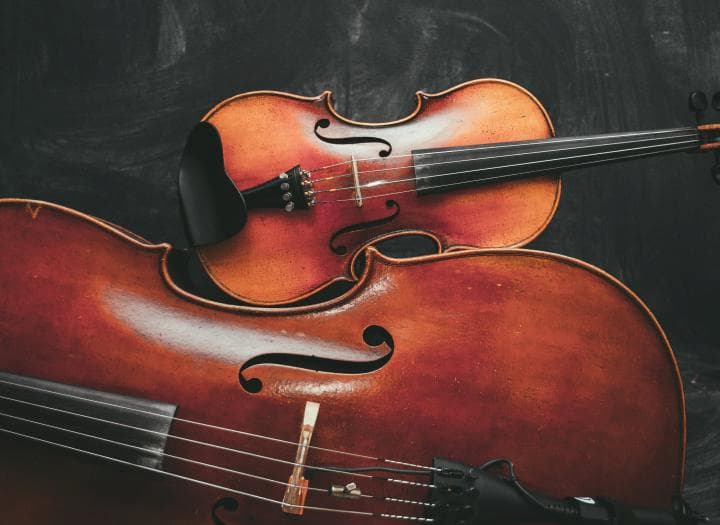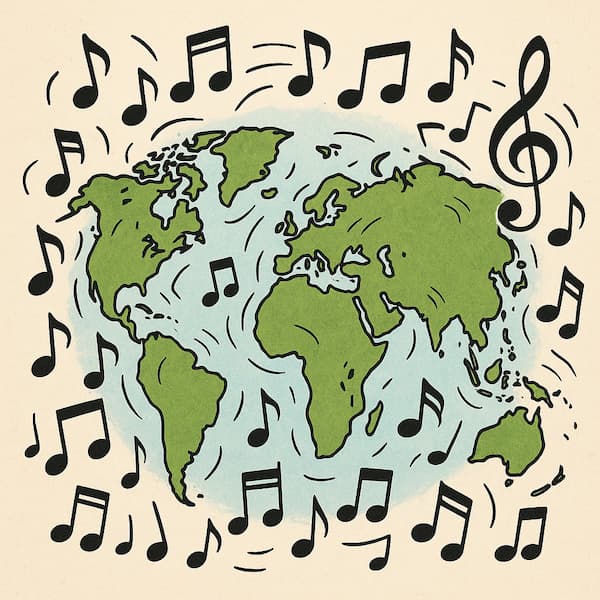The violin and cello: like vanilla and chocolate, they’re two great tastes that taste great together!
However, not everyone is familiar with the wide fantastic repertoire available to violinists and cellists who want to partner up and perform together. So today we’re looking at fifteen great works for violin and cello that expertly showcase the strengths of both instruments.

© airgigs.com
Vivaldi: Concerto for Violin and Cello in B-flat major (ca. 1725)
Over the course of his career, Italian composer Antonio Vivaldi wrote over five hundred concertos.
Many of them were written for a unique orchestra of women virtuosos. Although few women at the time pursued careers as solo instrumentalists, Vivaldi worked at a unique Venetian institution called the Ospedale della Pietà, which was a convent, orphanage, and music school.
At the Ospedale, the most musically talented orphaned girls were given a first-rate musical education. In return, they formed an orchestra and chorus that was one of the great cultural marvels of Europe. The income that came from the audience helped to sustain the wider orphanage.
It is almost certain that Vivaldi wrote this energetic concerto for these talented women.
Franz Anton Hoffmeister: Duet for Violin and Cello in C major, Op.6 No.1 (ca. 1780)
Franz Anton Hoffmeister (1754-1812) was a Mozart contemporary who was both a composer and a Viennese music publisher.
He was widely liked by his colleagues. Mozart dedicated a string quartet to him, and in a letter, Beethoven called him a “most beloved brother.”
This Hoffmeister duet for violin and cello is delightful late-classical fare. Unlike some duos of the era, both treble and bass instruments get consistently interesting parts to play.
Josef Reicha: Concerto for Violin and Cello in D-major (ca. 1780)
Josef Reicha was another Mozart contemporary, born in 1752 in the town of Chudenice, in the present-day Czech Republic. At the age of nine, he moved to Prague to further his cello studies.
In 1778, Reicha visited Leopold Mozart, Wolfgang’s father. Leopold was always a harsh critic, but he praised Reicha’s cello playing.
Two years later, Reicha adopted his nephew Anton. In 1785, Josef Reicha began conducting the orchestra in Bonn, Germany, Beethoven’s hometown. Anton Reicha quickly befriended Beethoven and became a respected violinist and composer in his own right.
The cello part in Josef’s violin and cello concerto is delightfully virtuosic: since he’s a cellist, the composer refuses to let the violinist have all the fun in this delightful late-Classical Era romp!
Benjamin Godard: Aubade for Violin and Cello (1874)
Benjamin Godard (1849-1895) was a French composer and violinist. He wrote a huge amount of music, including eight operas, but he’s probably best known for his shorter colorful works.
An “aubade” is a subgenre of love song that portrays the emotions of lovers upon separating at dawn. These songs were popular in the medieval era, and for Godard to write one in 1874 feels perhaps a touch ironic. That said, they became more and more popular in France in the final quarter of the century. This work, although written in 1874, was only published in 1892.
Johannes Brahms: Double Concerto (1887)
The Brahms Double Concerto has a sweet history: it was an olive branch extended to his old friend, violinist Joseph Joachim.
Beginning in 1884, Joachim went through a nasty public divorce, and despite his decades-long friendship, Brahms sided with his wife. That decision put their relationship in jeopardy. However, ultimately the two men reconnected to work on this concerto, with cellist Robert Hausmann joining them.
Unfortunately, the concerto’s reception was lukewarm at best. Vienna-based musicologist and writer Richard Specht went so far as to say it was “one of Brahms’ most inapproachable and joyless compositions.”
That may be taking things a bit too far! But in any case, even setting the quality of the music aside for a moment, the concerto was valuable in that it helped to patch things up between these two musical giants.
Reinhold Glière: 8 Pieces, Op. 39 for Violin and Cello (1909)
Reinhold Glière was born in Kiev in the mid-1870s. He studied violin at the Kiev Conservatory and then moved to Moscow and enrolled in the Conservatory there. He became a renowned teacher, pedagogue, and administrator, but he also continued writing music throughout his life. He survived Stalinist rule and World War II and died in 1956.
His 8 Pieces are absolutely lovely. They exude an antique feel, with movements titled after Baroque dances like Gavotte and Minuet, as well as tinges of Russian folk music.
Zoltán Kodály: Duo for Violin and Cello, Op.7 (1914)
Over the course of his career, Zoltán Kodály wore many hats: composer, ethnomusicologist, pedagogue, philosopher, and more. He was born in 1882 in Hungary. As a young man, he became fascinated by authentic Hungarian folk songs, and he and fellow composer Béla Bartók spent countless hours in the field, collecting and studying these works.
Kodály wrote this duo in 1914, on the eve of the Great War. It seems eminently possible that anxieties about political uncertainties found their way into this intensely virtuosic work.
The second movement begins with a heartbreaking cello solo. The violin and cello each sound as if they’re timidly asking questions of one other, and it’s unclear whether either of them uncovers any answers.
Frederick Delius: Double Concerto (1915-16)
In December 1914, British composer Frederick Delius went to a concert that had Brahms’s Double Concerto on the program. The soloists were two famous and accomplished sisters, May and Beatrice Harrison. May played the violin and Beatrice the cello.
After hearing their performance, Delius was inspired to write his own Double Concerto. He consulted with the Harrison sisters closely as he wrote. The result was a rhapsodic work with plenty of beautiful long phrases for both violinist and cellist to enjoy.
Maurice Ravel: Sonata for Violin and Cello (1920-22)
French composer Claude Debussy died in 1918 of cancer in the final months of World War I.
Distracted by the tragedy of the ongoing war, it took a while for the musical world to fully absorb Debussy’s loss. However, in 1920, a new music magazine called La Revue musicale assembled a commemorative supplement to pay homage to this late giant of French music.
Maurice Ravel contributed the first movement of this lean, intricately crafted sonata for violin and cello. He described the work this way: “The music is stripped to the bone. Harmonic charm is renounced, and there is an increasing return of emphasis on melody.” He continued working for months on additional movements after the supplement was published.
Erwin Schulhoff: Duo for Violin and Cello (1925)
Erwin Schulhoff was born into a Jewish family in Prague in 1894. He was a child prodigy who was championed by Antonín Dvořák. Later, he would study with Claude Debussy and Max Reger.
Schulhoff loved embracing new influences. He was fond of American jazz and the cacophony of Dadaism. However, that adventurousness counted against him when the Nazis came to power.
Between his musical interests, his ancestry, and his radical politics, his music was labeled degenerate, and he had difficulty finding work. He eventually died of tuberculosis in the Wülzburg prison in Bavaria.
But in 1925, the year this duo was written, all of that tragedy was still in the future. This duo is exciting and eccentric. It features a wide array of techniques, from the use of harmonics to mutes to pizzicato to whisper-soft dynamics.
Bohuslav Martinů: Duo for Violin and Cello, H.157 (1927)
Bohuslav Martinů was born in the town of Polička in the current-day Czech Republic in 1890. He began playing violin as a child and left home at sixteen to study in Prague. Conservatory life didn’t agree with him, and he was kicked out of his violin program, but maybe it’s just as well, as it allowed him to explore his burgeoning interest in composition.
His first duo for violin and cello consists of two movements. The opening is mesmerizing as the two instruments play similar notes together in the same range. The second movement is a virtuosic bow-hair-breaking rondo.
Heitor Villa-Lobos: 2 Chôros (bis) (1928)
Translated, “2 Chôros bis” means “Two Chôros encores.” The Portuguese word chôro means “weeping.” It eventually gained another meaning: a type of music played by Brazilian street musicians, who would play on a mix of Brazilian and European musical instruments.
Composer Heitor Villa-Lobos used the idea of chôros as inspiration for a wide-ranging set of works that he wrote in the 1920s, including this one.
The instruments are directed to create effects that seem to replicate the sounds of a guitar or drums.
Pál Hermann: Grand Duo I for Violin and Cello (1929-30)
Like Erwin Schulhoff, composer Pál Hermann’s career was cut short by the rise of Nazism. He was born to a Jewish family in Budapest in 1902. In his teens he studied at the Franz Liszt Academy of Music in Budapest. In his twenties he began a career as a concert cellist, while still writing music on the side.
At the time he was writing this duo, he was falling in love with a Dutch woman named Ada Weevers, who was not Jewish. They moved to Berlin together in 1931 shortly after this duo was finished and had a daughter together in 1932.
The following year, Weevers died young, and the year after that, Hitler rose to power. Hermann sent his daughter to be hidden with his wife’s relatives in the Netherlands while he hid on a farm in France. In 1944, he was rounded up by Nazi forces and sent on a train to the concentration camp in Kaunas, Lithuania. No further record exists of his fate.
Arthur Honegger: Sonatine for Violin and Cello, H. 80 (1932)
Arthur Honegger was a Swiss composer who is best remembered today for being a member of the Paris-based group of composers nicknamed Les Six.
In 1932, he wrote this elegant Sonatine for violin and cello. It is clearly inspired by historical aesthetics, drawing bits and pieces from the neoclassical style and gifted contrapuntists like Bach, but it always retains its modern edge.
This Sonatine was written in September 1932, a month after the birth of his daughter, which might account for its relatively light atmosphere.
Ellen Taaffe Zwilich: Double Concerto (1991)
American composer Ellen Taaffe Zwilich was born in 1939 and has had a remarkable compositional career. In 1983 she became the first woman to win the Pulitzer Prize for Music.
Her Double Concerto for violin and orchestra is written in a neo-romantic style. In program notes for the work, she described the structure of the double concerto like this: “The first [movement] begins lyrically, becomes agitated, then returns to a quiet close. The second movement is just the reverse; it starts very fast, changes character into an extended slow section, and finally returns to the faster tempos in an extended coda.”
Conclusion
As this list attests, there are many incredible works for these two instruments that aren’t played very often!
Do you have a favorite? Let us know!
For more of the best in classical music, sign up for our E-Newsletter


